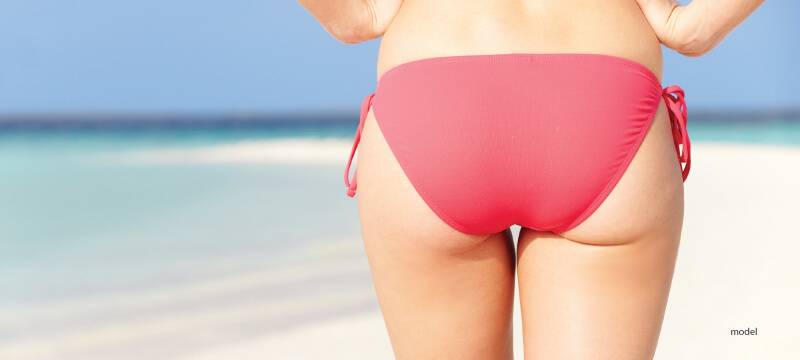Cellulite: 7 Things You May Not Know

Cellulite is extremely common. It affects an estimated 80% of all women.
While not at all harmful to one’s health, the appearance of cellulite may instill a negative body image. Some women refuse to wear shorts or bathing suits due to their cellulite.
And some women may simply want to better understand: what is it?
Generally, the puckering effect of cellulite is formed by normal fat pushing against normal connective tissue bands under the surface of the skin. Differences in the amount or the quality of the fat or connective tissues dictate whether such puckering effect is pronounced.
Cellulite can be classified in one of four levels of severity:
- Grade 1: No apparent cellulite, even if the skin is pinched
- Grade 2: Cellulite is only visible with skin pinched (not when standing or lying down)
- Grade 3: Cellulite is visible when standing but not when lying down
- Grade 4: Cellulite is visible both standing and lying down
Here are 7 additional interesting facts about cellulite:
- There are different types of cellulite. Cellulite can appear as discrete, deep dimples (often on the buttocks), a horizontal mattress appearance (often on the thighs), or a firm, orange-peel texture of the skin. Treatment options are tailored to the type of cellulite present with some types being easier to solve than others.
- Liposuction can’t treat cellulite! In short, cellulite exists in a layer not targeted by liposuction procedures. In fact, too much fat loss can lead to worsening of some types of cellulite by decreasing the support structure underneath the skin. So, if you are considering liposuction, make sure you discuss this with your surgeon. I always try to address this with my patients.
- Cellulite appears to have a hereditary component. Specifically, cellulite may be linked to genetics more than body weight. For women genetically predisposed to cellulite, even women with a low body mass index (BMI) can get moderate to severe cellulite, despite a healthy diet and regular exercise regimen.
- Cellulite targets specific areas of the body. Cellulite often occurs on areas of the body that are under the influence of the hormone estrogen (think – hips, thighs, buttocks). It also tends to occur on areas with lower blood circulation. Stimulating the local blood circulation and lymphatic drainage of the skin by regularly “body brushing” can help minimize the appearance of cellulite. Daily massaging and body scrubs may temporarily help too.
- Cellulite is linked to inactivity. Women with relatively inactive careers often have the most severe cases of cellulite. If your typical workday involves sitting at your desk for much of the day, try to take hourly breaks to walk around the office. Even better, schedule a regular lunch hour workout. While cardio exercise is important for heart health, even more important for cellulite improvement is building muscle. Increasing the quadriceps, hamstrings, and gluteal muscles can decrease the appearance of cellulite by alleviating the strain placed on the connective tissue bands.
- Dieting can make cellulite worse. Studies have linked crash diets, hormonal changes or imbalances, and dramatic metabolism changes as common factors that can aggravate cellulite. This is why women often see its dreaded appearance after puberty or pregnancy, or associated with large weight changes.
- Weight gain accentuates cellulite. Finally, of course, weight gain can increase the appearance of cellulite! Accordingly, reducing body fat levels may improve your cellulite, but the jury is still out on the role of any specific dietary modifications.
Treatment Options for Cellulite
There are several treatment options for cellulite, ranging from at-home topical creams to in-office laser and surgical procedures:
- There are a number of topical products on the market that make claims to eliminate cellulite. While some may offer minimal improvement, results are typically very temporary. Products that include retinol may help improve the skin texture, leading to a decreased appearance of cellulite. Products that include caffeine can temporarily plump the skin and mask the cellulite as well.
- Thermage is a radiofrequency device that delivers energy to the tissues in the skin creating tightening. Thermage can sometimes improve the appearance of cellulite, temporarily, as well.
- Avéli, a new FDA-approved cellulite treatment, addresses cellulite with a precise, minimally invasive in-office procedure. Avéli is the first cellulite treatment with the ability to identify and release the precise septa bands that lead to dimpling on the buttocks and thighs.
- Subscision is a minimally-invasive surgical procedure that, similar to Avéli, works by cutting the fibrous bands beneath the skin with a specially designed needle to release the bands causing tension. The subcutaneous fat below the skin’s surface is then redistributed evenly to create a smooth surface..
To learn more about cellulite treatment options, please contact us today for a free consultation.
Disclaimer: The contents of the Westlake Dermatology website, including text, graphics, and images, are for informational purposes only and are not intended to substitute for direct medical advice from your physician or other qualified professional.

I HATE CELLULITE!!!!